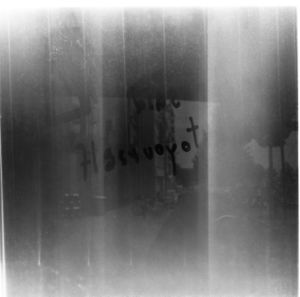Mia/self-directed methods 17.10. 2018
The interview
What are you making?
Currently, I am working on the focal camera with drawings as masks - we could call it ‘The Drawing Camera’ for instance. I want to merge photographs and drawings. To achieve this, I made a slit of plastic that is inserted in the camera in contact with the film. It can be pulled out, can draw on it,then slide it back and take the pictures.
Simultaneously, I just started with darkroom practice. I am continuing making photograms that I made in the past and I will also experiment with chemigrams - painting with chemicals in the darkroom. I am still in the initial stage, the technician gave me some suggestions but I’m still researching on what materials to use and how. I will use photographic paper, chemicals and enlargers instead of canvas,brushes and paint.
Why are you making it?
Mainly because it's related to my previous painting practice. Photography is something quite new for me right now, but I see what I’m currently making as a transition from painting to photography, that I feel are not that separate.
Does it relate to other things you have done?
Yes, I think photography and painting are very much related, also with printmaking bridging the two. I understand them more as a part of one broad way of making images.
How is it different to other things you have done?
The biggest difference I see is that photography is more mechanical, I am using more technology, even though analog. I've gone from simple tools like brushes and paint - that can be considered very bodily tools - to a camera which is a machine and is physically between me and the image. When I paint I'm closer to the image I am making whereas in photography there is a device and time in between.Also with photography I am producing black and white images - that is a big difference from my paintings that are mostly based on colour.
What are the most significant choices you made recently?
The shift from painting to photographs. But it was very natural and spontaneous. I'm trying to not make the same space as I had before. I used to work in a painting studio, an atelier and that kind of space is not part of my practice right now. I thought I was going to continue painting in a studio (maybe in the drawing station) but I'm not. My studio is now a desk with a computer and being surrounded by other people in the studio is also a change. So one of the choices was definitely not changing the workspace in an atelier but use other workspaces in the academy such a s the darkroom, printmaking workshop etc. I also actively chose to have the dark room workshops, they were not scheduled, but it was self-initiative to organise the introductory class in the darkroom. I want to continue with the handmade camera project as well. I choose not to abandon it even though we formally finished the project.
Suggested further readings
- Susanna suggested: John Alton: Painting With Light (in relation to the photograms, 'painting in the darkroom')
- Pierre Corider: Le Chimigramme (the Chemigram, 2007)
- Richard Farber: Historic Photographic Processes: A Guide to Creating Handmade Photographic Images (1998)
- Martin Barnes: Shadow Catchers: Camera-less Photography (2012)
- ali Martin Barnes: Cameraless Photography (Photography Library series; Victoria and Albert Museum)
- Christopher James: The Book of Alternative Photographic Processes (2nd edition)
- Vilem Flusser: Towards a Philosophy of Photography
- David Haines suggested: Charles Sanders Peirce on Semiotics (in relation to the drawing - camera)
Other References
- Tacita Dean
- Christian Schad
- Dieter Appelt (>>A snapshot steals life that it cannot return. A long exposure [creates] a form that never existed.<<)
- John Baldessari

